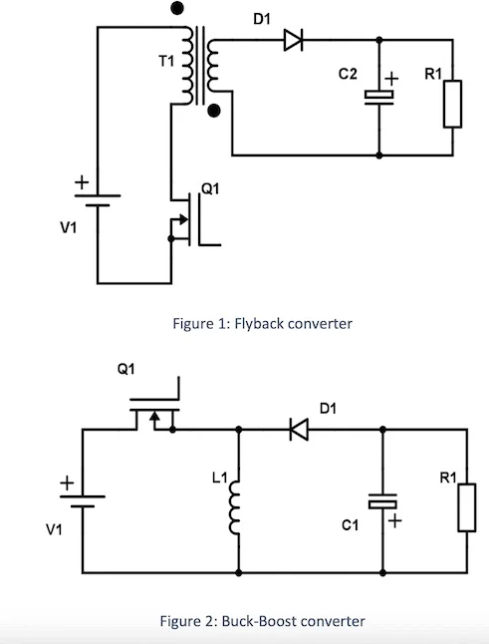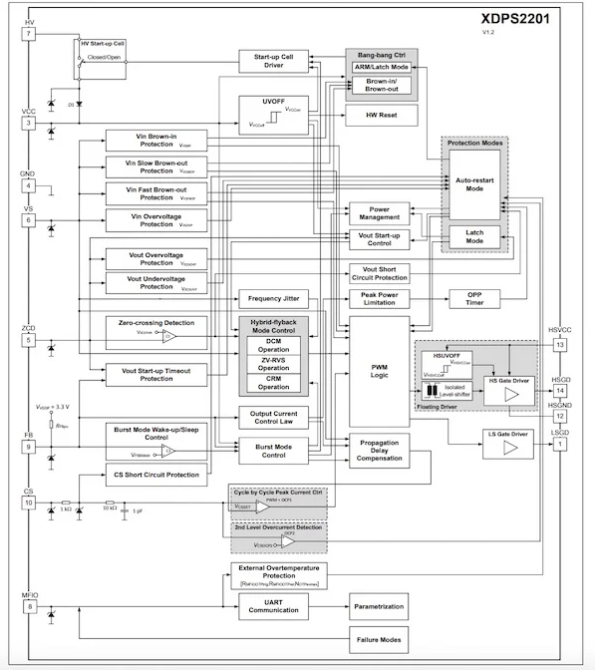In most wall-powered electrical systems, one of the significant sources of power loss is during the power conversion process. Between the wall power supply and the DC load, there is a need to rectify the AC to DC power and convert it from the rectified DC to a lower voltage regulated DC power. This whole process can result in significant power losses.
There are many converters that are designed to maximize efficiency. One example is the flyback converter, which has become increasingly popular due to its simple output filter design and ability to be used for multiple outputs. An example is the use of a flyback converter topology in a cell phone charger.
To that end, Infineon Technologies this week released a new series of reference designs for USB-PD-based chargers that utilize a flyback topology for maximum efficiency.
What is a Flyback Converter?
The flyback converter is a switching power supply (SMPS) DC/DC converter topology that operates in a mutual inductive manner.
In many ways, a flyback converter operates similarly to a buck converter. The main difference is that the flyback converter replaces the inductor with the primary coil of the transformer and utilizes the secondary coil as its output.

Examples of flyback and buck-boost converter circuits. Image courtesy of Anurag Gupta
These circuits typically use a pulse width modulation (PWM) signal to control the base of a switching transistor, thereby modulating the current flowing through the primary winding of the transformer. When current flows through the primary winding, energy is stored as a magnetic field. When the current stops flowing, the stored magnetic field disappears and the release of energy appears in the secondary winding where it is used as output. In a practical circuit, feedback is used to monitor the output voltage and control the PWM signal as needed.
The advantages of a flyback transformer include isolation between input and output, high efficiency of the SMPS, the ability to provide multiple output voltages, and importantly, the low number of components required compared to other SMPSs.

Block diagram of the XDPS2201. Image courtesy of Infineon Technologies
According to the company, their new power supply, the XDPS2201, combines the advantages of an asymmetrical half-bridge flyback topology and a resonant converter, enabling soft switching.
This soft switching minimizes switching losses and EMI, two of the biggest drawbacks of SMPS. Along with this, the converter also comes with an adaptive digital algorithm that allows it to achieve the highest possible performance under different and varying input and output conditions.
According to the datasheet, this converter can help achieve power densities above 20 W/inch^3 and efficiencies above 93%.
As the demand for faster charging of mobile devices continues to grow, more innovation is needed in this area. That appears to be exactly what Infineon has done here. While improving the efficiency of the flyback converter, it also helps to minimize issues such as EMI, which is a major step in the right direction.
Previous article:TDK launches compact transformer for DC/DC converters
Next article:STMicroelectronics launches high-performance automotive-grade GaN product portfolio
Recommended ReadingLatest update time:2024-11-16 13:30




- Popular Resources
- Popular amplifiers
-
 Practical Development of Automotive FlexRay Bus System (Written by Wu Baoxin, Guo Yonghong, Cao Yi, Zhao Dongyang, etc.)
Practical Development of Automotive FlexRay Bus System (Written by Wu Baoxin, Guo Yonghong, Cao Yi, Zhao Dongyang, etc.) -
 Principles and Applications of Automotive Embedded Microcontrollers: Infineon XC2000 Family MCUs
Principles and Applications of Automotive Embedded Microcontrollers: Infineon XC2000 Family MCUs -
 Automotive integrated circuits and their applications
Automotive integrated circuits and their applications -
 Research on CAN Gateway Based on Infineon MCU
Research on CAN Gateway Based on Infineon MCU
- MathWorks and NXP Collaborate to Launch Model-Based Design Toolbox for Battery Management Systems
- STMicroelectronics' advanced galvanically isolated gate driver STGAP3S provides flexible protection for IGBTs and SiC MOSFETs
- New diaphragm-free solid-state lithium battery technology is launched: the distance between the positive and negative electrodes is less than 0.000001 meters
- [“Source” Observe the Autumn Series] Application and testing of the next generation of semiconductor gallium oxide device photodetectors
- 采用自主设计封装,绝缘电阻显著提高!ROHM开发出更高电压xEV系统的SiC肖特基势垒二极管
- Will GaN replace SiC? PI's disruptive 1700V InnoMux2 is here to demonstrate
- From Isolation to the Third and a Half Generation: Understanding Naxinwei's Gate Driver IC in One Article
- The appeal of 48 V technology: importance, benefits and key factors in system-level applications
- Important breakthrough in recycling of used lithium-ion batteries
- Innolux's intelligent steer-by-wire solution makes cars smarter and safer
- 8051 MCU - Parity Check
- How to efficiently balance the sensitivity of tactile sensing interfaces
- What should I do if the servo motor shakes? What causes the servo motor to shake quickly?
- 【Brushless Motor】Analysis of three-phase BLDC motor and sharing of two popular development boards
- Midea Industrial Technology's subsidiaries Clou Electronics and Hekang New Energy jointly appeared at the Munich Battery Energy Storage Exhibition and Solar Energy Exhibition
- Guoxin Sichen | Application of ferroelectric memory PB85RS2MC in power battery management, with a capacity of 2M
- Analysis of common faults of frequency converter
- In a head-on competition with Qualcomm, what kind of cockpit products has Intel come up with?
- Dalian Rongke's all-vanadium liquid flow battery energy storage equipment industrialization project has entered the sprint stage before production
- Allegro MicroSystems Introduces Advanced Magnetic and Inductive Position Sensing Solutions at Electronica 2024
- Car key in the left hand, liveness detection radar in the right hand, UWB is imperative for cars!
- After a decade of rapid development, domestic CIS has entered the market
- Aegis Dagger Battery + Thor EM-i Super Hybrid, Geely New Energy has thrown out two "king bombs"
- A brief discussion on functional safety - fault, error, and failure
- In the smart car 2.0 cycle, these core industry chains are facing major opportunities!
- The United States and Japan are developing new batteries. CATL faces challenges? How should China's new energy battery industry respond?
- Murata launches high-precision 6-axis inertial sensor for automobiles
- Ford patents pre-charge alarm to help save costs and respond to emergencies
- New real-time microcontroller system from Texas Instruments enables smarter processing in automotive and industrial applications
- EEWORLD University - What is an antenna vibrator?
- [RISC-V MCU CH32V103 Review] First Look at CH32V103
- May was quite busy, and my hand broke.
- Pre-registration for the prize-winning live broadcast | Infineon system solutions make electric motorcycle design more reliable and efficient!
- What methods do you generally use to recruit or find jobs? Which platform is used more often?
- Summary of the points to note when using CCS8.0 to program MSP430G2553
- A fire broke out at Foxconn in Shenzhen, with thick smoke billowing from the scene
- PCB copper plating
- Color card combination lock
- Taking a “family-first” approach to op amp design

 Practical Development of Automotive FlexRay Bus System (Written by Wu Baoxin, Guo Yonghong, Cao Yi, Zhao Dongyang, etc.)
Practical Development of Automotive FlexRay Bus System (Written by Wu Baoxin, Guo Yonghong, Cao Yi, Zhao Dongyang, etc.)
















 京公网安备 11010802033920号
京公网安备 11010802033920号